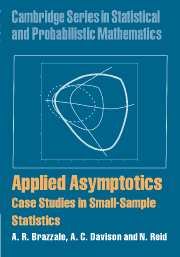Book contents
- Frontmatter
- Contents
- Preface
- 1 Introduction
- 2 Uncertainty and approximation
- 3 Simple illustrations
- 4 Discrete data
- 5 Regression with continuous responses
- 6 Some case studies
- 7 Further topics
- 8 Likelihood approximations
- 9 Numerical implementation
- 10 Problems and further results
- A Some numerical techniques
- References
- Example index
- Name index
- Index
9 - Numerical implementation
Published online by Cambridge University Press: 19 November 2009
- Frontmatter
- Contents
- Preface
- 1 Introduction
- 2 Uncertainty and approximation
- 3 Simple illustrations
- 4 Discrete data
- 5 Regression with continuous responses
- 6 Some case studies
- 7 Further topics
- 8 Likelihood approximations
- 9 Numerical implementation
- 10 Problems and further results
- A Some numerical techniques
- References
- Example index
- Name index
- Index
Summary
Introduction
A superficially appealing way to implement higher order inference procedures would be to write general routines in a computer algebra system such as Maple or Mathematica, designed so that the user need provide the minimum input specific to his or her problem. One would use these routines to derive symbolic expressions for quantities such as r*, and then evaluate these expressions numerically, concealing the hideous details in the computer. Many models have special structure which this approach does not exploit, however, leading to burdensome derivations of intermediate quantities which then simplify enormously, and symbolic computation packages are generally ill-suited for numerical work on the scale needed for applied statistics. Thus although computer algebra systems can be powerful tools for research in higher order asymptotics, those currently available are unsuitable for passing on the fruits of that research to potential users. It is possible to interface separate packages for symbolic and numerical computation, but this halfway house is system-dependent and demands knowledge of advanced features of the packages.
A more practicable approach recognises that many classes of models can be treated in a modular way, so higher order quantities can be expressed using a few elementary building-blocks. In some cases these must be computed specifically for the problem at hand, but the rudimentary symbolic manipulation facilities of environments for numerical computing such as R can then be exploited. A technique that we call pivot profiling can then be used to obtain higher order quantities for the range of interest, by computing them over a fixed grid of values between which they are interpolated.
- Type
- Chapter
- Information
- Applied AsymptoticsCase Studies in Small-Sample Statistics, pp. 170 - 184Publisher: Cambridge University PressPrint publication year: 2007

